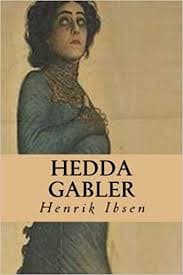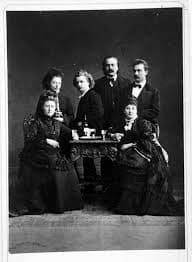The play Hedda Gabler, written by the great Norwegian playwright Henrik Ibsen premiered in 1891. It details Hedda’s struggles as a newlywed with an existence she finds devoid of excitement and enchantment. She is the daughter of an aristocratic general and has just returned to her villa in Kristiania from her honeymoon. Her husband George Tesman is a young, aspiring but not brilliant academic, and it becomes clear that Hedda has never loved him but married him because she thinks her years of youthful abandon are over.

Hedda Gabler
Things get dicey when the rival academic Eilert, who had been Hedda’s former lover, appears on the scene. Eilert is in a relationship with Thea, who had left her husband to be with him, and he is working on his masterpiece, a sequel to his recently published work. Hedda is jealous of Thea, and when George returns home from a party he reveals that he found the complete manuscript—the only copy—of Eilert’s great work. Hedda convinces Eilert to commit suicide, and subsequently burns the priceless manuscript. It sounds like an imaginative work of fiction, but in reality, some aspects are based on the relationship of Ibsen’s compatriot composer Johan Svendsen and his wife Sarah Levett.
Johan Svendsen: Norwegian Rhapsody No. 3, Op. 21 (Latvian National Symphony Orchestra; Terje Mikkelsen, cond.)

Johan Svendsen
The son of a humble orchestra musician, Johan Svendsen (1840-1911) was born in Kristiania, now called Oslo. Musically highly gifted, he received a scholarship from a wealthy merchant to study at the Leipzig Conservatory in 1863. His teachers included Ferdinand David and Carl Reinecke, and he became close friends with Richard Wagner and with his fellow countryman Edvard Grieg. When Svendsen completed his studies in 1867, he unanimously received the first prize in composition. He returned to Kristiania in August of 1867 and gave two concerts in the city. Grieg wrote an enthusiastic review, “On this day Norwegian art has celebrated one of its great triumphs. For triumph, it may be called, when a musically ignorant audience, consisting of only a few hundred, is torn by the absolutely new and great that they forget their heirloom, and breaks into enthusiastic enthusiasm.” Artistic success none withstanding, Svendsen was unable to make a living in his hometown and sought his fortunes in Paris. He arrived in February 1868 and stayed there until March 1870. And it was in Paris that he met the singer and entertainer Sarah Levett. She was the daughter of a wealthy New York dentist, and she was living large in Paris under her stage name “Sally.”
Johan Svendsen: Violin Concerto in A Major, Op. 6 (Arve Tellefsen, violin; Oslo Philharmonic Orchestra; Karsten Andersen, cond.)

Johan Svendsen
A whirlwind affair quickly ensued, and the relationship between Johan and Sally was tumultuous from the very beginning. Madly in love with each other, they nevertheless broke up multiple times before once again celebrating reconciliation. Things came to a head when Sally abruptly decided to return to New York. But Johan had made up his mind, and in the summer of 1871, he traveled to New York to marry his Sarah. He took her back to Europe and they initially settled in Bayreuth, becoming close friends with the Wagner family. Since Sarah Svendsen was Jewish, Richard and Cosima Wagner persuaded her to be baptized, and she took on the Christian name “Bergljot.” Eventually, the couple moved to Kristiania and uneasily settled into a marital routine. With his 2nd Symphony, Johan had finally reached the peak of his career as a composer, but he spent significant time away from home on extended conducting engagements in Germany, Italy, England, and France.
Johan Svendsen: Symphony No. 2 in B-flat, Op. 15 (Bergen Philharmonic Orchestra; Neeme Järvi, cond.)

Edvard Grieg, Edmund Neupert, Johan Svendsen and their wives
With Bergljot sitting at home in Kristiania and her husband gallivanting through Europe, it is hardly surprising that the relationship quickly descended into chaos. And it was during these tumultuous times that the famous “Hedda” anecdote supposedly took place. In a fit of rage, anger, and jealousy, Bergljot supposedly threw the only copy of Johan’s Symphony No. 3 into the fire in 1883. We have no idea what music the flames consumed, but Johan did at that time work on sketches for a likely symphony. These were found in 2007 and eventually reconstructed and performed in 2011. The “Hedda” incident became the catalyst for the final breakup of the relationship, and Bergljot moved to Paris. The marriage was officially dissolved in December 1901, and 2 weeks later Svendsen married the Danish dancer Juliette Vilhelmine Haase, with whom he already had three children. Immortalized by Ibsen, the composer Johan Svendsen is today primarily remembered for his enchanting Violin Romance, Op. 26.
For more of the best in classical music, sign up for our E-Newsletter


Excellent article. Whatever one knew about Svendsen, this surely expanded it. He was an almost contemporary of Grieg and might have been on his shadow musically, as his pieces are academic and not very memorable (as Grieg’s!). Except, of course, his ROMANCE for violin & orchestra Op 26. Nice video!!